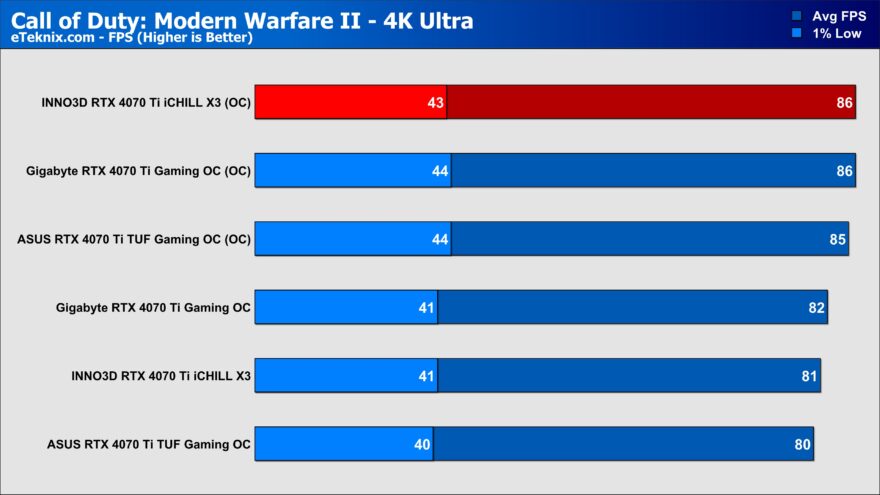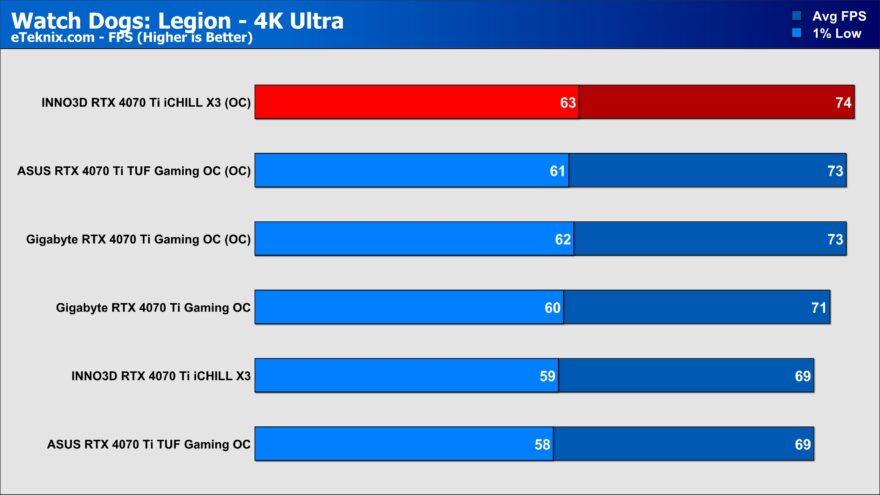Inno3D RTX 4070 Ti Graphics Card Review
Peter Donnell / 1 year ago
So the stock performance of this card is pretty much what you would expect. All of the 4070 Ti’s stay right around the same performance milestone with only a few percentage differences between each card, not favouring any card in particular. Where the cards really start to stand out from each other is in the thermal performance and power usage, and to get these measurements we ran F1 22 for an hour loop to get an idea of where levels sit during a gaming session, and what we found was that the GPU temperature sat around the 66-degree mark with the hotspot reaching up to highs of 81 degrees, placing it above both other 4070 Ti cards we’ve previously looked at. The memory however sat much lower than the other two cards, at just 60 degrees under sustained load. Power usage was also on the slightly higher side, with a peak power draw of 289 Watts, while the fans stayed at a fairly reasonable 1520 RPM, which wasn’t particularly audible during our test.
In terms of how this compares to the other RTX 4070 Ti cards we’ve had in our offices, it is the hottest, the most power hungry and the loudest, but with only small margins between them and going up against the likes of the ASUS TUF Gaming and Gigabyte Gaming OC, it’s not exactly a deal breaker and is very unlikely to be noticed during gameplay anyway.

So with our card now tested at stock, it’s time to look at how well we can overclock it and whether it’s worth doing in the search for some free performance.
After cranking up the temperature limit, we set to work and managed to increase the core clock by 150MHz bringing our clock speed now up to 2460MHz with a boost speed of 2820MHz. The memory clock was also increased by 1200MHz, now giving us a memory clock speed of 1463MHz or a little over 23Gbps Effective.
Once we were happy with the levels of stability, we ran F1 22 again for another hour to get our thermal and power results while also giving us the opportunity to test the stability of the overclock and make sure that we’ve got the card to a point where you could happily play for hours without artifacting or crashes.
What we noticed is that there was very little difference in our temperatures, with the GPU only going up by a single degree after the overclock whilst the GPU hotspot temperature didn’t change at all and still stayed around that same 81 degrees. On top of this, the memory temperature ended up going down by 2 degrees, now at 58, but none of this is too surprising as when we look at the fan usage we can see that it’s risen to 1631 RPM in an aim to keep the components cool while under the extra stress. In terms of power, while the limits couldn’t be raised, the overclock does come at a cost to it now using around 6% more power overall.
This now means that the INNO card when overclocked takes the top spot, above both the ASUS and Gigabyte cards, and what’s more interesting is that those two cards sit below the stock performance of the iCHILL X3, even when they are overclocked in terms of temperature, and apart from the ASUS card, in power too, though not by any significant margin.
OC Game Performance

So like before, we start things off with Call Of Duty Modern Warfare II, where we see a 6% uplift in performance over stock, which places the card only 1% over the overclocked ASUS TUF Gaming card and in line with the performance from Gigabyte. The 1% lows also saw a small jump up by 4%, but Inno3D had the lowest 1% lows of the cards, sitting 2% below both of the other cards.

Next up is Cyberpunk, and here we see a 4% boost in performance over stock in the averages and a 2.5% improvement in the 1% lows. Compared to the other cards, the iCHILLl still remains at the top of our stack commanding the same 4% lead in performance that we saw at stock.

Death standing sees a 2.5% increase in performance over stock in the averages, while at the same time, the ASUS TUF Gaming takes a stronger lead, now putting it at the top of the stack, a place where it shared identical performance at stock before. The 1% lows also saw just under a 5% increase in performance, though the ASUS card managed a slightly stronger lead of just under 6%.

Lastly in Watch Dogs: Legion, the INNO3D card again takes the top spot, by increasing its performance by 7% in the averages and a smaller, but still admirable 6% in the all-important lows. This now puts it around 1% faster than both the ASUS and Gigabyte cards which are priced very similarly.



















